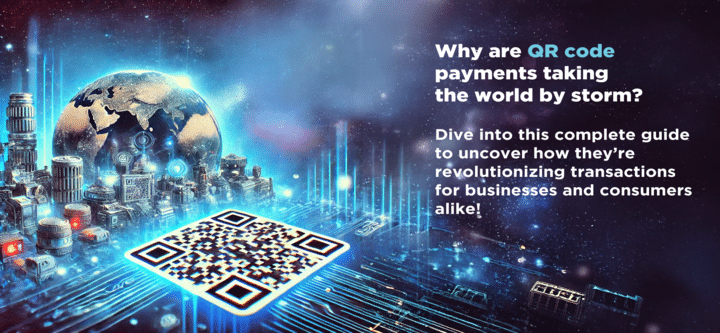In December 2024 that over 16.73 billion UPI transactions were conducted in India, highest ever for a single month and a mammoth 79% of it were through QR Codes.
This staggering aspect puts QR code at the center of the digital payment revolution in India. Once confined to niche tech enthusiasts, QR code payments are now ubiquitous—from street vendors in bustling markets to high-end retailers in metropolitan cities.
This payment method’s meteoric rise is no coincidence. Its ability to blend simplicity, speed, and security has made it a favorite among consumers and businesses. As per Statista’s Digital Payments Report (2024), the global QR code payment market has seen an annual growth rate of 17% and is expected to hit $20 billion in valuation by the end of 2025.
This trend reflects a significant behavioral shift, fueled by the increasing penetration of smartphones, the push for cashless economies, and innovations from fintech leaders like Evolute Fintech Innovations.
For businesses, QR code payments represent an opportunity to streamline operations, reduce transaction costs, and offer customers a seamless shopping experience. For consumers, it eliminates the hassle of carrying cash or cards, providing a secure and hassle-free payment method.
In this blog you will get a comprehensive understanding of the latest development in QR code payments that will further revolutionize the payment industry and the present and future of transactions.
What Are QR Code Payments? Breaking Down the Basics
QR Code Payments are a form of digital transaction where a Quick Response (QR) code acts as the payment medium. These codes are two-dimensional barcodes that store payment information, such as the receiver’s account details, making them a simple yet powerful tool for financial exchanges.
When a consumer scans the QR code using a smartphone or payment app, the encoded payment details are decoded, enabling a seamless transfer of funds. This system supports various payment modes, including:
- UPI-Based Payments: Popular in countries like India, linking directly to bank accounts.
- E-Wallets: Used by apps like PayPal, Google Pay, and Paytm.
- Card-Linked Payments: For businesses that integrate credit or debit card systems with QR codes.
This technology eliminates the need for physical cards or point-of-sale (POS) terminals, making it especially useful for small businesses and informal markets. With the ability to integrate static and dynamic codes, QR Code Payments cater to a wide range of use cases, from individual merchants to global enterprises.
The beauty of QR Code Payments lies in their universality—they work across devices, platforms, and industries, making them one of the most versatile digital payment solutions available today.
Why QR Codes Are Everywhere
QR codes, or Quick Response codes, are two-dimensional barcodes that can store data and be scanned using smartphones. What makes them ubiquitous is their simplicity, affordability, and adaptability. With over 4 billion smartphone users globally as of 2024, according to Statista, QR code payments are poised to become a universal mode of transaction.
Global Adoption Rates and Trends
- India: According to the NPCI, UPI transactions crossed 13 billion in June 2024, with 75% involving QR codes.
- China: QR codes dominate, with over 83% of mobile payments being QR code-based as per a 2024 Alipay report.
- United States: A survey by Juniper Research predicts 2x growth in QR payment users by the end of 2024, fueled by retail giants adopting the technology.
- Africa: QR codes are transforming payments, offering fast, mobile-based transactions. High mobile phone use and government support drive their growth, boosting financial inclusion.
How QR Code Payments Work: A Step-by-Step Guide
Understanding how QR Code Payments work can demystify their growing popularity among businesses and consumers. The process involves a seamless integration of technology to ensure a smooth and secure transaction. Here’s a breakdown:
Generation of the QR Code: Businesses or merchants create a QR code using a payment service provider.
-
- Static QR Codes: These are fixed codes containing predefined payment information, often used by small businesses or for recurring transactions.
- Dynamic QR Codes: These are transaction-specific codes generated in real-time, offering enhanced security and additional payment details, such as invoice numbers.
Scanning the Code: Consumers scan the QR code using a smartphone camera or a mobile payment app like Google Pay, Paytm, or Alipay. The app decodes the QR code, extracting the necessary payment details such as the merchant’s account information.
Payment Authentication: Once the payment details are decoded, the consumer enters the amount (if not predefined) and confirms the transaction. Authentication methods, such as:
- PINs or Passwords
- Biometric Verification (fingerprint or facial recognition) are used to ensure security.
Real-Time Processing: The payment request is routed through the payment gateway or processor, which verifies the transaction details with the consumer’s bank or wallet. Upon approval, the funds are transferred instantly to the merchant’s account.
Confirmation of Payment: Both the consumer and merchant receive real-time confirmation. For businesses using advanced systems like Evolute’s Fintech Micro ATM or Thermal Receipt Printers, a printed receipt can also be generated for physical proof of the transaction.
Underlying Technologies in QR Code Payments
- Tokenization: Sensitive data is replaced with unique tokens to ensure security.
- NFC Integration: For devices equipped with Near Field Communication, enhancing speed.
- End to End Encryption: Data exchanged during the transaction is encrypted, safeguarding against fraud.
This simple yet robust process ensures that QR Code Payments are fast, secure, and universally accessible—one of the key reasons behind their rising global adoption.
Why QR Codes Are Becoming More & More Popular
QR codes, or Quick Response codes, have seen exponential growth as payment methods worldwide. According to a report by Statista (March 2024), the global QR code payment market is projected to reach $20 billion by 2025, with Asia-Pacific leading the adoption curve. This trend owes its momentum to the simplicity, security, and convenience that QR code payments offer.
A noteworthy example comes from India’s Unified Payments Interface (UPI), where QR codes facilitated transactions worth ₹18.41 trillion in January 2024 (Economic Times). For consumers, this means a tap-and-go ease; for businesses, it’s about seamless integration into digital ecosystems.
Amplifying Indian Fintech Growth: The QR Code Revolution
India has emerged as a global leader in fintech innovation, and QR code payments have been instrumental in this transformation. From empowering micro-merchants in remote villages to redefining urban retail experiences, QR codes are at the heart of India’s digital payment boom.
The National Payments Corporation of India (NPCI) reported in December 2024 that over 16.73 billion UPI transactions were conducted in a single month, with a significant portion initiated via QR codes. Initiatives like Bharat QR and UPI QR codes have made these systems accessible and efficient, creating a robust foundation for financial inclusion.
Financial Inclusion for All: QR codes have simplified banking for millions, enabling even non-tech-savvy users to make digital payments. Rural merchants, who previously relied on cash, now accept digital payments seamlessly through QR codes linked to UPI apps.
Boosting MSMEs: Micro, Small, and Medium Enterprises (MSMEs), which form the backbone of India’s economy, have witnessed a substantial boost. A 2024 study by NASSCOM revealed that QR code payments increased MSME revenue by an average of 30%, as they could now cater to a broader audience.
Government Push for Cashless India: Programs like Digital India and Make in India actively promote QR code adoption. Incentives, such as reduced transaction fees for merchants, have further accelerated adoption. Additionally, QR-enabled government-to-person (G2P) payment systems are making subsidy distribution more efficient.
Innovations by Indian Fintech Leaders: Fintech companies like Evolute Fintech Innovations have been pivotal in driving this growth. Evolute’s Leopard Micro ATM and biometric-enabled payment devices seamlessly integrate QR functionality, ensuring merchants in both urban and rural areas can benefit. Such innovations address the dual need for advanced technology and localized solutions.
International Recognition and Investment: India’s success story has attracted global attention, with foreign investors and governments keen to replicate this model. The World Bank’s Digital Payment Report 2024 cited India as a case study for scalable QR payment solutions that can be adapted worldwide.
The rise of QR code payments is not just about convenience—it’s a catalyst for India’s fintech growth. By bridging the gap between technology and accessibility, QR codes are enabling a cashless economy, boosting financial inclusion, and solidifying India’s position as a global fintech powerhouse.
Why Businesses Should Love QR Code for Payment
For businesses, QR code payments open a world of opportunities:
- Cost Efficiency: Minimal setup costs compared to traditional card payment systems.
- Improved Customer Experience: QR codes offer a frictionless, intuitive payment process.
- Real-Time Transactions: Instant fund transfers reduce wait times and improve cash flow.
Companies like Evolute Fintech Innovations are empowering businesses to harness QR technology through cutting-edge solutions like Leopard. Designed for retail and micro-merchant ecosystems, Leopard terminals integrate QR code payments seamlessly with biometric authentication and receipt printing.
According to a 2024 survey by McKinsey, 78% of small businesses in emerging markets that adopted QR payments saw a 25% increase in sales within the first year. This demonstrates the game-changing potential of adopting such fintech solutions.
Why QR Code Payments Are Worth Your Scan
Consumers benefit from QR code payments through:
- Convenience: No more fumbling with cash or cards.
- Security: Encrypted transactions protect personal and financial data.
- Inclusivity: QR payments cater to both smartphone users and feature-phone adopters via UPI-linked services.
As PwC’s Fintech Report 2024 notes, 68% of global consumers now prefer QR code payments over traditional methods for everyday purchases.
Evolute Fintech’s Role in Shaping Fintech QR Code Payments
Evolute Fintech Innovations is at the forefront of QR payment evolution, creating products that cater to both merchants and consumers. Their Fintech Micro ATM supports QR code transactions, ensuring inclusivity across rural and urban landscapes. Additionally, Evolute Finetch’s Thermal Receipt Printers streamline transaction records, bridging the gap between digital and physical documentation.
Challenges in QR Code Adoption in Payments
While QR codes are promising, they come with challenges:
- Cybersecurity Risks: Malicious QR codes can redirect users to phishing websites.
- Digital Divide: Rural regions with limited internet access may struggle with adoption.
- Standardization: Global uniformity in QR code formats remains a work in progress.
To address these, initiatives like Evolute Fintech focus on secure hardware and software integration are crucial.
As Bill Gates aptly said, “The advance of technology is based on making it fit in so that you don’t really even notice it.” Evolute’s solutions exemplify this philosophy by blending security with usability.
Looking Forward: The Future of QR Payments
The trajectory of QR code payments is undeniably upward. Emerging technologies like AI and blockchain will likely enhance their functionality further, enabling features like predictive analytics, cross-border payments, and Integration with IoT and Wearables.
In 2024, countries like Brazil, India, and Indonesia are leading the charge by integrating QR codes into their national payment systems, fostering economic inclusion. As a business or consumer, staying ahead of this trend isn’t just about convenience—it’s about staying relevant in a digital-first world.
Conclusion: The Revolution is Here, and It’s Scannable
QR code payments represent more than just a technological shift—they are a cultural revolution. They simplify lives, empower businesses, and democratize access to financial systems.
As you navigate this dynamic landscape, consider leveraging Evolute Fintech Innovations’ robust product ecosystem to stay competitive. Whether you’re a consumer enjoying the ease of tap-and-pay or a business looking to scale, the rise of QR code payments offers unparalleled opportunities.
It’s time to embrace the scan—because the future of payments is here, and it fits in the palm of your hand.





